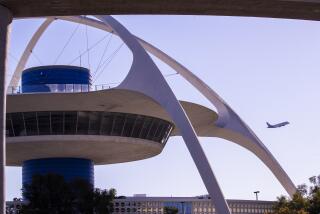Jetliner Aborts Approach at LAX After Near Miss : Aviation: Larger aircraft was approaching the same runway as another plane as the two come within an eighth of a mile of each other, FAA officials say.
- Share via
A Brazilian jumbo jet and a smaller USAir plane, separated by only an eighth of a mile, approached the same runway at Los Angeles International Airport on Sunday before the larger plane aborted its landing and pulled up, the Federal Aviation Administration said Monday.
A Varig Airlines 747-400 and a USAir 737-300 were on final approach shortly after 10 a.m., said FAA spokeswoman Elly Brekke. The Varig plane, Flight 830 from Brazil, had been cleared to approach Runway 24 Right with instructions to “sidestep” on approach and land on Runway 24 Left, a parallel runway, Brekke said. The two runways are separated by about a mile.
“We had USAir also approaching 24 Right,” Brekke said. “The pilot was told to follow the Varig plane to the airport.” The USAir plane was operating visually, a common practice “perfectly within federal regulations,” she said.
The USAir pilot told controllers it had the Varig jet in sight, and controllers advised Varig that a USAir plane was approaching for landing on 24 Right, Brekke said.
“What occurred was apparently the Varig flight did not complete that sidestep approach and continued to head for 24 Right,” Brekke said. Within a mile of the airport, “the Varig pilot decided to pull up, abort his landing and go around.”
The USAir 737 landed safely on 24 Right, she said. The incident comes about a year after a USAir 737 crashed into a commuter plane that a controller had also cleared onto the same runway.
It was the preliminary judgment of the control tower Sunday that the two planes were about an eighth of a mile apart horizontally, Brekke said. “We have not determined the vertical separation.”
Parallel approaches are an accepted practice she said. “It is often done on a clear day to expedite the flow of traffic,” she said. “The intent was that this would be a parallel approach when the Varig plane sidestepped.”
It is a common practice for a pilot to approach one runway, using radio navigation signals for that runway, then make a visual landing on a parallel runway, Brekke said.
“There is no set distance by which they must sidestep,” Brekke said. “We need to review the radar tape to determine where this pilot was. We are reviewing data to determine whether a formal investigation is warranted.”
A pilot has the authority “at all times” to pull up and use the “go-around” procedure without “prior air traffic control permission,” Brekke said. She said opting to use the procedure does not imply that a pilot has made an error.
“The go-around procedure is there for the pilot to use,” she said. “The (Varig) pilot obviously felt it would be unsafe to make a landing--obviously a wise decision.”
USAir spokesman Larry Pickett said his company’s Flight 2251, from San Francisco to Los Angeles, carried 122 passengers and six crew members.
A spokesman for the National Transportation Safety Board said his agency considers incidents such as this “serious,” but he said he was unable to say whether an investigation has been ordered.
Varig Airlines could not be reached for comment.
More to Read
Sign up for Essential California
The most important California stories and recommendations in your inbox every morning.
You may occasionally receive promotional content from the Los Angeles Times.













